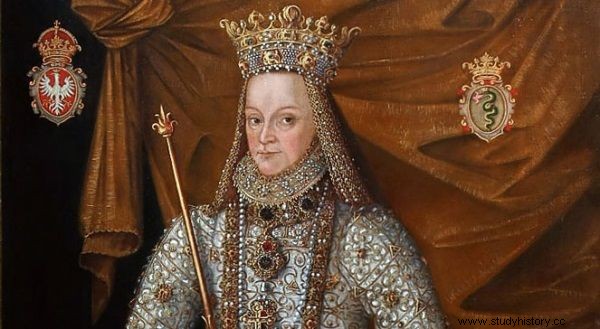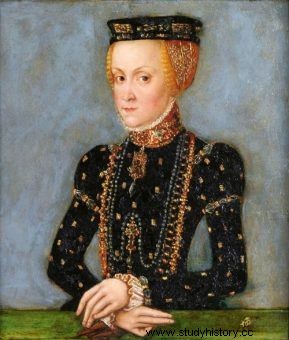A bitter old maid, a devotee, the ugliest Polish queen. Anna Jagiellonka was not respected during her life and after her death. How much truth is in her black legend? And why did the daughter of the most powerful Polish ruler get married only at the age of 52?
No one was interested in Anna. And it has always been like that. Her mother only noticed her once. When the girl was born on October 18, 1523, Bona Sforza, with anger and disappointment, ordered a quick, routine baptism to be prepared. She did not even wait for the return of her husband, who was at the Sejm, with the ceremony. She drummed her duty, put her daughter in the care of a guardian, and her personal relationship with Anna ended there. She did not boast of giving birth to anyone. There was no son born, so there was nothing to write about in the letters.
This disinterest was taken over from Bona by her husband and then her son. Everyone treated Anna as if she were invisible. It is known about the young king that he was always "stern of mind" towards her. The fate of his sister began to weigh on his heart only when his presence was felt by the royal treasury. Bona left the country, and someone had to contribute to the maintenance of the queens.
Already on the occasion of the wedding of elderly Zofia Jagiellon, Hetman Jan Tarnowski explained the position of Zygmunt August. "For His Majesty it is better that the expenses decrease, because it is easier for two sisters to keep than more" - he said. It was even easier to keep one. Or it's best not to keep any. There was no question of personal sentiments here. The youngest of the Jagiellonians, Katarzyna, stated directly that Zygmunt August "was never a brother to her". And Anna Jagiellonka could say the same.
The ugly Jagiellonian duckling
In 1556, she was no longer a young girl. She was thirty-three years old and if Zygmunt August wanted to marry her, he had to act quickly. At this point, neither the appearance nor the health of the princess stood in the way of marriage.

Anna Jagiellonka did not get married until the age of 52. Her life has become a real school of patience.
In the portrait taken a year earlier, she still looks fresh and advantageous. His face is thin, his lips are soft and the features are pleasant to the eye. Her body shape is also small and in line with the tastes of the era.
According to her biographer, Maria Bogucka, she is not "completely devoid of charm" in this picture. Although you can see the beginnings of future ugliness - too high forehead, slightly bulging eyes, pointed chin - but Anna can still like her. She certainly looks a lot better than her own mother of a similar age.
The problem with getting married was elsewhere. Zygmunt August did not want to overpay. This, in turn, sentenced Anna to a procession of random and undecided candidates for her hand.
The Duke of West Pomerania, Jan Fryderyk, withdrew from the talks as soon as he heard how low the Jagiellonian's dowry was. His brother Barnim was just as adamant. Perhaps a matrimonial relationship with the sister of the Polish king gave a chance for a beneficial alliance, but the Pomeranians had their honor. And they weren't going to take their wife for free. Anyway, it was difficult for them to swallow Anna's age. Jan Fryderyk was twenty years younger than her. Barnim - over twenty-five.
A procession of pathetic candidates
The king's envoys tried to encourage one of the Habsburgs to marry. In Vienna, however, the proposal to marry Anna was taken as a joke. A promising opportunity finally opened up in Württemberg. Thanks to the efforts of her sister, Duchess of Brunswick Sophia, Anna received a wedding proposal from the twenty-three-year-old Prince Eberhardt. So what if the bachelor unluckyly died right after the matchmakers were dispatched.
Another potential spouse, brother of the Rhenish palatine, Richard Wittelsbach, did not even negotiate. Thirty-two thousand florins of dowry seemed to him an amount offending his dignity.
A particularly determined candidate appeared in Denmark in the person of the royal brother Magnus. "God has visited him, he does not have one eye and is a poor drunkard" - Katarzyna Jagiellonka wrote about him. In other words:madman, blind man, bankrupt and alcoholic. Even Danish historians called him a "failed and degenerate" man.

Young Anna Jagiellon in a portrait from the workshop of Łukasz Cranach the Younger.
As if the flaws were not enough, Magnus had a bishop career behind him, he was an unrepentant adventurer and a young man - there was an almost twenty-year age difference between him and Anna.
Zygmunt August very much wanted to get rid of his sister. He himself admitted in a letter to the Radziwiłł family that he dreams of "not wearing this obligation anymore". But the Danish proposal was just overkill.
The competitions were rejected, while Anna felt humiliated anyway. After all, this pathetic troublemaker and madman was the only man really ready to marry her. It did not give her much hope that fate might still change.
Young and beautiful… but not Anna
There was no longer anyone to send questions about marriage to. Anyway, if there was a serious candidate, Anna was still losing in the competition with her sister. Katarzyna was younger, prettier and more self-confident. Even the Grand Duke of Moscow, Ivan IV the Terrible, chose her.

Ivan IV the Terrible. Even he did not want to marry Anna Jagiellonka.
His delegation arrived in Vilnius in 1560. The MPs were not allowed to speak to the princesses, but were reportedly shown to them through the small window of the castle. The staging was to emphasize Anna's humility and diligence. Both royal sisters were sitting at the wheel and spinning distaff . The distance helped to hide the wrinkles and traces of the passing years. It was to no avail. Ivan stated that if he was to marry someone, it would only be with Catherine.
The marriage with the prince did not take place, but the situation repeated itself after two years. The envoys of the prince of Finland, Jan Vasa, came to Vilnius. They wanted to match their master with the Polish princess - but of course only with the young and beautiful one.
This approach caused consternation at the court of Zygmunt August. Virgins should always be married according to their birth order. In this case, this principle seemed particularly important. Being married to Katarzyna would be a signal that Anna's marriage was a lost business. And that it is high time to come to terms with the lifelong primordiality of the thirty-nine-year-old Jagiellonian girl.
The speculation was finally interrupted by Anna herself. She went to the king and demanded that he "no longer deprive Princess Catherine of happiness." It was more difficult to convince the interested party herself.

You will learn about the tragic story of Anna Jagiellon in the book by Kamil Janicki. Ladies of the golden age (Horizon Label 2014). Buy with a discount on empik.com.
Anna and Katarzyna were extremely close. Together, they endured the despotic urges of their mother and the ill-treatment of their brother for many years. Together they saved themselves from the fire, lived together, played and suffered together. The sisterly bond had already been strained. Before that, there were three of them, but Zofia got married and moved to Braunschweig.
Since then, they have been exchanging letters continuously, sending each other advice and expressions of support. “Your Ducal Majesty deigns to remember well our love when we lived together. One without the other did not go where it was needed. Always all three side by side. I am always serving Your Majesty with this love, ”Katarzyna wrote in one of her messages to Zofia. However, the sisters knew that the separation would be irrevocable. And that correspondence contact is only a shadow of what they have had so far.
It just was
Catherine hesitated for a long time, but finally decided that she did not want to hear about any wedding. "I do not want a different state than the one in which I am now," she replied when Anna and Zygmunt August came to her together. She preferred to stay with her sister and endure old age together. She was sure Anna would just applaud her decision.

Zofia Jagiellonka (on the left) was the wise one, Katarzyna was the beautiful ...
Meanwhile, she began to force her to leave. "But Your Majesty before me you gave permission to me! Why say anything else now? " She huffed. Confused, Katarzyna paused. Anna was just waiting for it.
With a pugnacious face, she turned to Sigismund August:“She gave permission, Merciful King! Please do not ask Your Majesty any more! ”. There was no point in arguing any further. Katarzyna accepted Jan Waza's proposal and left for the far north. And only Anna knew how much this one conversation cost her.
She never had a strong character. Out of all three, Zofia was the firm and intelligent one, Katarzyna was the beautiful one. And she? It just was. As long as she had her sisters with her, she didn't need any guts, cleverness, or flirtatiousness. In their inseparable trio, each complemented the shortcomings of the others. And there was no doubt that it was Anna who benefited the most.

And Anna? She just was.
She made an act of true resolve only once in her life - precisely during a conversation with Catherine and August in 1562. There is no doubt what she really felt. "Anna is dissatisfied that the younger one was issued before her," noted the secretary of one of the courtiers of Sigismund Augustus, and at the same time an agent of Albrecht Hohenzollern. Little to say.
The princess was suffering as if part of her body had been torn off. She condemned herself to a life of endless loneliness, contempt and helplessness. And if she felt anything else, it was the fact that at least she had made her beloved sister happy. She could not see that she had actually condemned Katarzyna to many years of ill-treatment and a life of constant fear. But that's a completely different story.
Source:
You can learn more about the confusing history of the Jagiellonian family in Kamil Janicki's book Ladies of the golden age (Horizon Label 2014). The article is based on the literature and materials collected by the author during the work on the book. You can buy it at a discount on empik.com.
